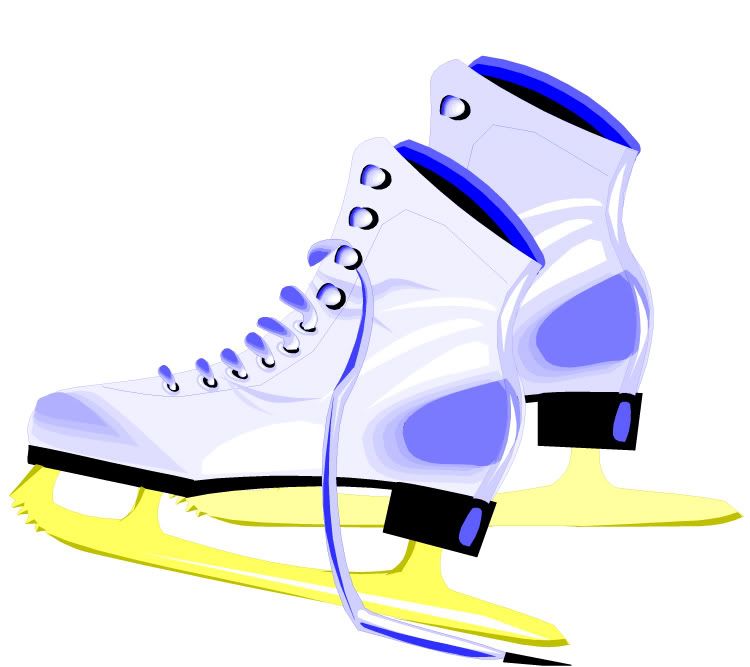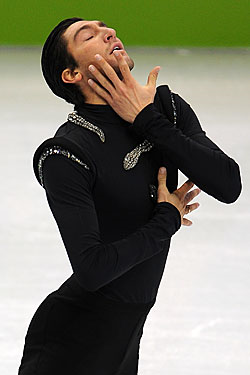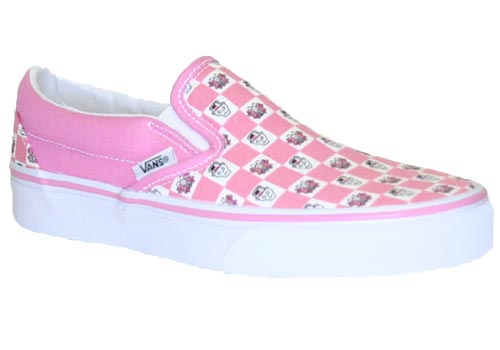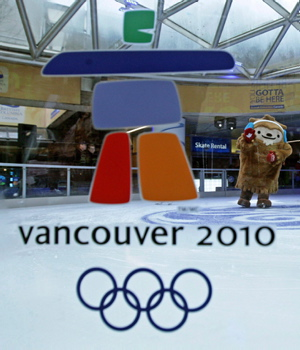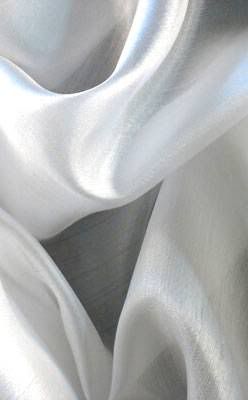Note from Ice Mom: All of my reviews are unpaid. All editorial content on Ice Mom is independent of advertising content.
Another note from Ice Mom: Lauren Downes, MSPT, and creator of Sk8Strong, has written a great response to this post. I've included it at the bottom of this post because I think all readers should see it. Thank you, Lauren.
If you’ve been reading this blog for any amount of time, you know I’m cheap. However, if you’ve been involved with skating for any length of time, you’ll also know that cheap people have limited opportunities for that thrifty feel-good experience.
In the spirit of saving money on off-ice training, I purchased both the
Sk8Strong Off-Ice Training for Figure Skaters Manual and the
Developing the Youth Skater DVD last year. Physical therapist, off-ice trainer, and professional figure skating coach Lauren Downes, MSPT, developed the
Sk8Strong program to help figure skaters accomplish off-ice training without having to employ a personal trainer. The Professional Skaters Association (PSA), which is the professional organization that certifies USFSA coaches and offers them professional development, has endorsed the Sk8Strong products. That’s a pretty big endorsement.
I’ve waited to write this review because I am a mom, not a fitness expert. So, to help me with the fitness part, I enlisted my fellow ice mom, physical therapist J.H. (Thank you, J.H.!)
Please note that Sk8Strong offers other products like a video analysis of the skater, individual skater assessments, seminars for clubs, paid membership to an online resource bank, and free databases of local off-ice trainers and nutritionists. This review doesn’t cover any of those additional offerings because I haven’t used any of those services.
Developing the Youth Skater DVD - $39.95
I bought the DVD that’s for low-level skaters, ages seven and up, but preliminary and lower. Sk8Strong also has videos for
The Competitive Skater, Adult Training, The Ultimate Dynamic Warmup, and
Core Stability Training.
The
Developing the Youth Skater DVD comes with an insert that lists the exercises, repetitions and sets, and progression for a young or low-level skater. The video has three circuits of exercises, 25-40 minutes each. Each of the 27 exercise demonstrations lasts about a half minute, more or less.
Physical therapist J.H. said that overall the video had a good variety of exercises and the exercises were some of her own daughters’ favorites.
J.H. had some favorites, too, especially the demonstration of the advanced version of the lunge. She also liked the ITY exercise, the single leg bridge, the reach pull, the diagonal ball reach, the toe taps, the push up, the lateral step down, the single leg dead lift, the plyo off box, and the 2-foot squat jumps. The reach-pull, she said, would be great to work on jump rotation.
“Very good form is demonstrated on the video,” J.H. said. “The demonstrator is spine-neutral with good ab control, good alignment of leg, which means that the knee is in line with the hip or ankle.”
However, J.H. cautions users that some of the exercises like the crab walk, the crab alternating leg, and the crab bridge wouldn’t be for skaters with shoulder laxity or problems. She also said that the hip abduction exercises were very basic and that skaters could skip them, especially if they’re short on time.
She also wants skaters to make sure that they move from the shoulder blade first when they do the ITY and Rowing exercises.
“It’s a good beginner program,” J.H. said. “But I’d like to see more plyometrics. It would probably be helpful to the skater to have a professional watch them complete the program to give feedback on proper form.”
From a mom’s point of view, I have to say I’m disappointed in the video. I mean, I know the exercises and the circuits are helpful and the demonstrator is terrific, but the video isn’t user friendly.
Here’s what I mean: the video demonstrator performs the exercises in each circuit in sequence, but the demonstrations don’t last as long as it takes for a skater to do the number of repetitions and sets.
In other words, it’s not like a regular exercise video where the living room athlete can sweat with the professionals on TV in real time. Instead, skaters need to find the circuit they’re working on, watch the demonstration of the exercise, pause the DVD, and then complete the reps. When skaters are done with that exercise, they grab the remote, push Play again, watch the next demonstration, pause the DVD, and complete the reps.
That’s not 7-year-old, beginner skater friendly. If your skater is that young, you’ll have to sit next to her the entire time and run the remote for her. My 14-year-old doesn’t like the DVD for that reason. The first time we went through it, she and I were really frustrated that we couldn’t do the exercises in the same time as the demonstrator – until we realized that we were supposed to do the watch-and-pause thing. Ice Girl would rather put on some aerobics or dance workout video where she can bop along with the folks in the studio instead of pause the player every 30 seconds.
Bottom line: The DVD is full of very sound information and practice; however, I don’t think I would buy the next video in the series. We just don’t use this one very much.
Sk8Strong Off-Ice Training for Figure Skaters Manual - $28.95 (downloadable version: $24.95)
I’ll tell you right off the bat: this one’s worth the $30 or so. Ice Girl uses the manual all the time.
The 38-page manual contains photos, descriptions, and progressions for each exercise in all of the Sk8Strong DVDs. It has articles about the importance of stretching, functional training vs. gym machines, what a skater needs to be successful, exercise circuits for each skater’s level, blank training logs, and a periodization chart. It also includes the breakdown of an Axel.
The exercise chapters are:
- Dynamic Warmup Exercises (includes muscle activation, mobility, traveling mobility, dynamic mobility, static stretching, and foam roll warm-ups.)
- Core Exercises
- Upper Body Exercises
- Lower Body Exercises
- Plyometrics
Physical therapist J.H. likes the binder, too. “The exercises with the foam roller are good and the periodization is very good,” she said. “You have to have different training all year round because you want to peak [in performance] when your competition is coming around.”
J.H. is a stickler for form, though. When we looked over the plank positions, she went to the floor and demonstrated how it’s supposed to look. J.H. is very fit. The top of her body was in a straight line from her toes to her neck.
“The plank position photos [in the manual] show a rounded back,” J.H. said. “But the shoulder blades should be set, not shrugged. They should make a straight line from ankle to shoulders to hips. The butt shouldn’t be up and the arms are way up too high.”
She went on about butt position in the push-up photos, too, with more floor examples. “See?” she said as she demonstrated a push-up. “You have to keep on your toes. If you can’t keep that position on your toes, be on your knees. No butt up; that’s a cheat.”
J.H. did like the exercises that Downes chose for the manual. She thinks that skaters will find them fun and not at all boring. Many of the exercises use affordable gym equipment like the foam roller, medicine ball, phisio ball, and sport cords. At first I was put off about buying the extra equipment, but Ice Girl really likes using it. No idea why equipment makes off-ice more fun, but it does.
The manual includes several reports at the end and are included as examples of what membership Sk8Strong on the Web contains.
You know, I’m a good reader. I read all the time. I taught English and journalism for 10 years and I’m a professional writer. However, the one-page Skill Analysis, “The Breakdown of an Axel,” mystified me. I couldn’t figure out what I was reading, why I was reading it, and what use it would be to Ice Girl (although she did put a star at the top of the page).
The report contains sentences like:
The iliopsoas lifts the thigh to achieve a proper ‘step-up,’ and the quadriceps assists with hip flexion and control of the knee.
Um. If you say so.
J.H. read it and said that the report made perfect sense to her, but she’s a physical therapist. She said that her daughters wouldn’t know what to do with the report and most coaches wouldn’t, either.
I did like the Sk8Strong Injury Report sample (again, something you’d receive as a paying member). “Ankle Sprains vs. Tendonitis” describes what each injury is and what to expect during recovery. I also liked “The Importance of Stretching.” The report explains why and where skaters should warm up before skating, what the muscles do, what can happen if skaters don’t warm up, what kind of stretching is the best, and how much a skater needs to stretch. Both reports were readable and useful.
The manual’s material is copyrighted and the photos are made up of very fine dots. I had thought about photocopying the manual for Ice Girl to use and lose so I’d be able to have a master copy. Photocopying doesn’t work well with the photos: they become muddy and hard to view. You shouldn’t photocopy it, anyway, beyond using it as a back-up.
Bottom line: This manual was definitely worth the $28-something. Ice Girl keeps it in the van (most of the time) and refers to it. The photos are small, but the positions are well documented and obvious. I like the text description of each exercise, the recommendations for skating ages/levels, and the periodization.
Recommendation from physical therapist J.H.: “It would be more helpful to the skater to use a professional trainer for an hour and then use the video and manual as a reference during home training. A trainer costs typically $60 – 90 per hour. The trainer will design a program and evaluate the skater so the trainer knows what the skater’s strengths and weaknesses are and can create a program that fits the individual.”
-----RESPONSE FROM LAUREN DOWNES OF SK8STRONG:-----
Hello, this is Lauren from Sk8Strong. Thank you icemom and JH for taking the time for the thorough review! I would like to address a few points you have made, as we expected these type of comments when creating the programs.
The DVDs were meant to be instructional, and not a workout video that you could follow along the reps and sets of each exercise. Each skater is different and progresses at a different pace, and may progress one exercise faster than another. Therefore, a 'follow along' video would not do justice to every skater; it would possibly lead a skater to doing exercise progressions that he or she is not ready for. Yes, it is more boring for the skater, yet it is safer. Initially, the skater will follow along and pause each exercise; as time goes on, he or she will become more comfortable with the program and be able to do it by memory to their own music, or whatever keeps their interest!
At the beginning of each DVD, Sk8Strong states that it is highly recommended that a skater meet with a qualified health professional to assure that the exercises are being performed correctly. Not everyone will listen to that advice, yet it is very important. Yes, a DVD cannot take place of a set of trained eyes. They were created as a reference for fitness professionals, parents and coaches to use as a guideline for an appropriate exercise program. We have received many positive and thankful comments from athletic trainers, personal trainers, and physical therapists around the globe. I have seen many coaches without fitness credentials holding off-ice classes that are not appropriate for skaters, and if they are going to hold these classes, my goal was to give them the proper education. Nothing will take place of a physical therapist or certified strength and conditioning specialist, but if everyone becomes more educated, that is my goal :).
Regarding specific exercises such as hip abduction, that is actually one of the most important exercises for a young skater to do! The hip abductors play a large role in single leg stability, which is necessary in the majority of skating moves. In about 75% of skaters I have evaluated, there is a very large weakness of this muscle groups. Weakness can lead to knee problems, and will also affect the forementioned skating moves. A young skater needs to master technique of the basic exercises first, and then move along to more difficult ones. The Compeititive Skater DVD significantly addresses this muscle group with advanced exercises. In the ITY exercise, we do instruct to lead the motion with the shoulder blades. The point made about the crab bridge exercises is right on point. Also, regarding the pictures in the manual of the prone plank; yes, the buttocks is a little too high. I did that to assure that skaters don't dip down too low and cause an arch in the lower back.
Regarding plyometrics, we include a full plyometric progression in the Competitive Skater DVD. We only include the 2 foot squat jumps and beginning plyos in the Youth DVD, because skaters that young don't have the strength and stability to do single leg and more advanced plyos with the correct stability and body mechanics. This is why they are included in the higher level DVD.
Again, thanks for taking the time to write a review. We listen to all criticism, positive or negative, and use that feedback to better our programs. Our goal was to provide the skating community with safe, effective programs to better skaters' ability and performance, prevent injury, and educate everyone involved with a skaters' training.
Lauren Downes MSPT
Sk8Strong Inc.
Have you bought any Sk8Strong materials? What did you think of the program? Please add your experiences in the comments so everyone can benefit.
Update: From reader Anonymous/Sk8rmom who is a trainer and a mom (good, long, informative comment - you should read the whole thing): I have to agree with JH. Thank you for promoting the idea of actually going to a person rather than to learn ONLY from the manual or DVDs. As a Personal Trainer who works with skaters, I can't emphasize enough how much getting expert advice specific to your child's age, maturity, physical and mental needs, and their athletic goals and stage is priceless! Our children are growing and changing daily, it's important to take that into consideration. [...] I have not seen the DVDs, but had considered purchasing them as a resource. I probably will, but as a mom, I would not let the TV be my child's trainer. I could see recreational adults or older teens using them as such. No doubt they are good resources. However, there is no substitute for the personal touch.
Update: From reader Anonymous: I agree 100 % that the hip abductors are one of the MOST important muscle groups for any athlete, and weakness contributes to a variety of overuse injuries of the lower extremity. However, I feel there are more functional ways to get at the hip abductors than the side lying exercise described. This may be a good way in the beginning to isolate the muscle so that the skater knows what the contraction of this muscle feel like, but it does not integrate it into a weight bearing activity and simulate how the muscle is used in skating. I prefer exercises such as step downs and lunges that incorporate the entire LE.
Update: From reader C.D. via e-mail to icemom.diane@gmail.com: We ordered Sk8strong because my daughter wanted to start doing some off-ice conditioning, and our rink doesn't offer anything geared towards lower level skaters (and the classes they do offer happen at times when my daughter is in school). I wanted to be sure she got some instruction as to proper form, but wasn't willing to commit to private conditioning training (yet), so Sk8strong (the beginning skater version) seemed to fit the bill. Having reviewed it with my daughter a few times, the exercises are, indeed, appropriate and to my non-expert eye, appear to model good form. But the pacing is not quite right--they jump right from exercise to exercise, and run through them a bit too quickly. Maybe my daughter will be able to keep up after gets used to the exercises and the sequence, but for now, we have been using the pause button on the DVD player to let her watch the example, then do the exercise at her own pace. (IceMom suggested that we should get the book/binder that goes along with the set, which probably would have been helpful, but my husband placed the order and thought that was too expensive, so at least for now the watch/pause system will work for us.) Overall, I am not sorry I spent the money to order this as an educational piece to teach my daughter some new exercises and proper form, but I am not sure how well it will hold my daughter's attention long term.
Do you have a question for Ice Mom and/or the Advisory Board? Do you have an idea for a post? Are you an expert and you want to write a guest post? Great! E-mail Ice Mom at icemom.diane@gmail.com




